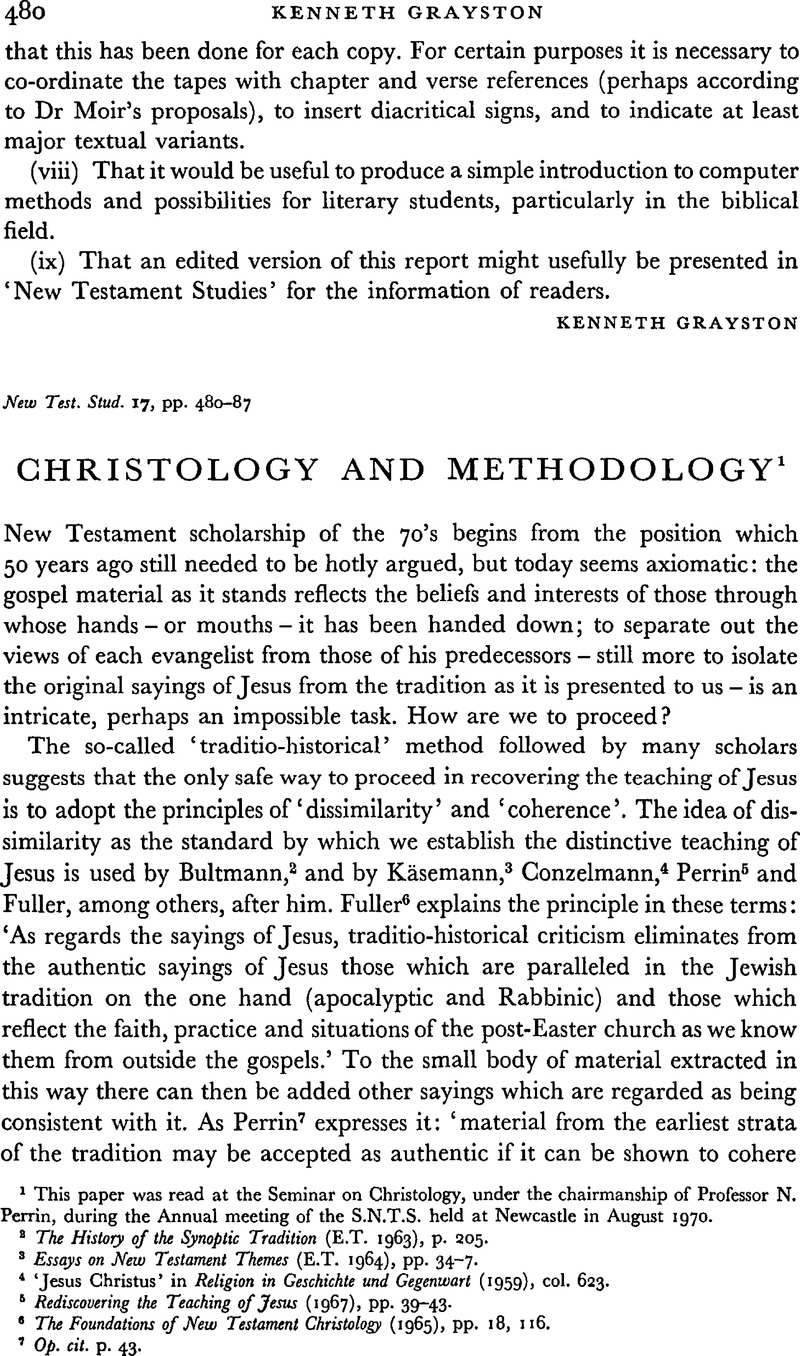Published online by Cambridge University Press: 05 February 2009

page 480 note 2 The History of the Synoptic Tradition (E.T. 1963), p. 205.Google Scholar
page 480 note 3 Essays on New Testament Themes (E.T. 1964), pp. 4–7.Google Scholar
page 480 note 4 Jesus Christus’ in Religion in Geschichte und Gegenwart (1959), col. 623.Google Scholar
page 480 note 5 Rediscovering the Teaching of Jesus (1967), pp. 39–43.Google Scholar
page 480 note 6 The Foundations of New Testament Christology (1965), pp. 18, 116.Google Scholar
page 480 note 7 Op. cit. p. 43.
page 481 note 1 We must therefore disagree with the statement of Zahrnt, H., The Historical Jesus (E.T. 1963)Google Scholar: There is today general agreement on this basic principle of method.’
page 481 note 2 N. Perrin, loc. cit.
page 481 note 3 R. H. Fuller, for example, refers to sayings which pass this test as the more characteristic parts of Jesus’ teaching' op. cit. p. 103. What he means is that they are distinctive’ in the other sense. Cf. N. Perrin, op. cit. p. 39: If we are to seek that which is most characteristic of Jesus, it will be found not in the things which he shares with his contemporaries but in the things wherein he differs from them.’ This assertion of Jesus' uniqueness is a dogmatic assumption. Cf. the criticism of Downing, F. G., The Church and Jesus (1968), p. 116.Google Scholar
page 482 note 1 Cf. Hooker, M. D., The Son of Man in Mark (1967), pp. 6 f.Google ScholarNineham, D. E. in Christ for Us Today, ed. N. Pittenger (1968), p. 58, n. 18.Google Scholar
page 482 note 2 Perrin's statement that the Gospels offer us directly information about the early church, (What is Redaction Criticism? (1970), p. 69Google Scholar) is over-optimistic.
page 482 note 3 Cf. F. G. Downing, op. cit. pp. 114 f.
page 483 note 1 Cf. R. H. Fuller, op. cit. p. 18; Perrin, N., Rediscovering the Teaching of Jesus, pp. 37 fGoogle Scholar.; and the criticisms of F. G. Downing, op. cit. pp. 113 f.
page 483 note 2 Op. cit. pp. 164–75, 197–8.
page 483 note 3 Op. cit. p. 41.
page 483 note 4 Gottesreich und Menschensohn in der Verkündigung Jesu’, Festschrift für Günther Dehn, ed. W. Schneemelcher (1957), pp. 51–79;Google ScholarJesus und der Menschensohn’, Z.Th.K. LX (1963), 133–77.Google Scholar
page 484 note 1 Gegenwart und Zukunft in der synoptischen Tradition’, Z.Th.K., LIV, (1957), 277–96.Google Scholar
page 484 note 2 So Schweizer, E.; see Der Menschensohn’, Z.N.T.W. LX (1959), 185–209Google Scholar; The Son of Man’, J.B.L. LXXIX (1960), 119–29Google Scholar; The Son of Man Again’, N.T.S. IX (1963), 256–61.Google Scholar
page 484 note 3 Loc. cit.
page 484 note 4 See, most recently, the article by Leivestad, R., which challenges these assumptions: Der apokalyptische menschensohn ein theologisches Phantom’, pp. 49–105,Google Scholar in Annual of the Swedish Theological Institute, VI (1968).Google Scholar Cf. also N. Perrin's discussion, referred to above, p. 483, n. 2.
page 485 note 1 N. Perrin, op. cit. p. 39.
page 485 note 2 What is Redaction Criticism?, p. 70. A similar misunderstanding is found in Higgins's, A. J. B. essay Is the Son of Man Problem Insoluble?’ in Neotestamentica et Semitica, Studies in Honour of M. Black, ed. E. Earle Ellis and Max Wilcox (1969), p. 73.Google Scholar
page 485 note 3 The Son of Man in Mark, p. 5.
page 486 note 1 See R. H. Fuller, op. cit. p. 109; Knox, J., The Death of Christ (1959), pp. 78–80.Google Scholar
page 487 note 1 Cf. M. D. Hooker, op. cit. pp. 182–93; R. Leivestad, op. cit. pp. 80–91.
page 487 note 2 Op. cit. p. 248. Fuller himself recognizes this when he writes on page 130: Jesus understood his mission in terms of eschatological prophecy and was confident of its vindication by the Son of man at the End…Take the implied self-understanding of his role in terms of the eschatological prophet away, and the whole ministry falls into a series of unrelated, if not meaningless fragments.’ We may accept the underlying truth of this statement, without necessarily agreeing that the term eschatological prophet’ is the correct one.